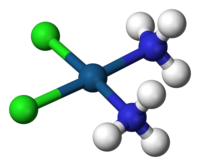
Photo from wikipedia
Tripodal chiral ligands containing amino acid residues and salicyl-acylhydrazone units were synthesized and used to obtain coordination cages through deprotonation and coordination to gallium. These coordination cages have Ga3L2 stoichiometry… Click to show full abstract
Tripodal chiral ligands containing amino acid residues and salicyl-acylhydrazone units were synthesized and used to obtain coordination cages through deprotonation and coordination to gallium. These coordination cages have Ga3L2 stoichiometry and pinwheel geometry with two types of chiral centers built into their walls: stereogenic centers at the amino acid backbones and stereoselectively induced centers at metal ions. The pinwheel geometry is unique among analogous cages and originates from the partial flexibility of the ligands. Despite the flexibility, the ligands induce the chirality of metal centers in a highly stereoselective way, leading to the formation of cages that are single diastereoisomers. It has also been demonstrated that stereoselectivity is a unique feature of cage geometry and leads to effective chiral self-sorting: homochiral cages can be obtained selectively from the mixtures of racemic ligands. The configuration of metal centers was determined by circular dichroism, TD DFT calculation, and X-ray crystallography.
Journal Title: Inorganic Chemistry
Year Published: 2022
Link to full text (if available)
Share on Social Media: Sign Up to like & get
recommendations!